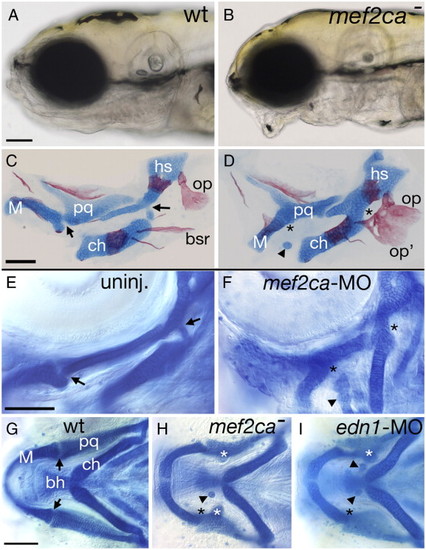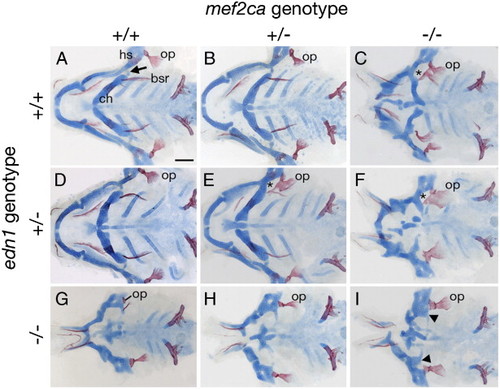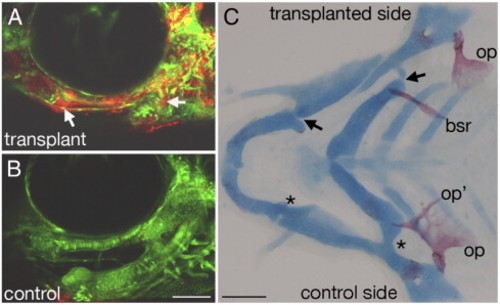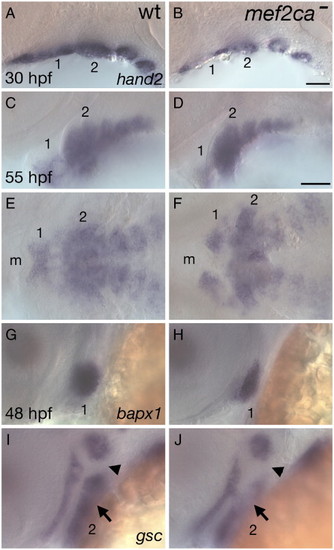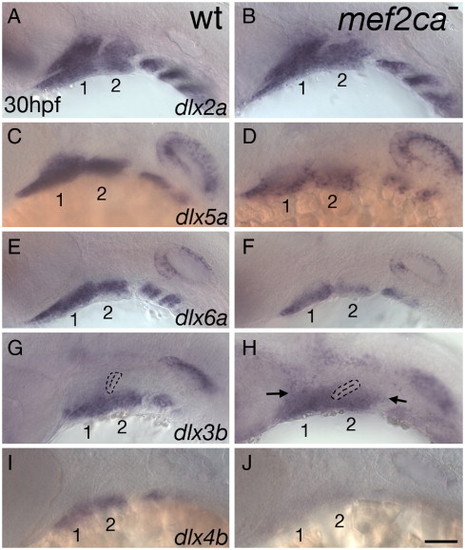- Title
-
mef2ca is required in cranial neural crest to effect Endothelin1 signaling in zebrafish
- Authors
- Miller, C.T., Swartz, M.E., Khuu, P.A., Walker, M.B., Eberhart, J.K., and Kimmel, C.B.
- Source
- Full text @ Dev. Biol.
|
Reduction of mef2ca function causes facial deformities which phenocopy partial edn1 loss-of-function. (A–B) Live phenotypes of mef2ca mutants at 5 dpf. mef2ca mutants have malformed faces, open mouths, and ventrally displaced jaws. (C–D) Cartilage and bone phenotypes in the pharyngeal arches of mef2ca mutants. Dorsal/ventral joints (arrows) are missing in mef2ca mutants (asterisks). Mutants also have ectopic cartilage nodules (arrowhead), distinctive ectopic medial processes emanating from the upper jaw cartilage (see Table 1) and homeotic transformations of hyoid dermal bone identity. In mef2ca mutants, a ventral hyoid bone, the branchiostegal ray, is enlarged, assumes the shape of and fuses to the dorsal hyoid bone, the opercle. (E–F) mef2ca-MO injection phenocopies mef2ca mutations. Lateral views of wholemount 4.5 dpf wild-type larvae, uninjected (E) and injected with 5 ng of mef2ca morpholino (F). mef2ca-MO injected fish display characteristic mef2ca mutant cartilage phenotypes. Joints are lost (asterisks) and ectopic cartilage nodules (arrowhead) are seen near the basihyal. (G–I) mef2ca mutation phenocopies gradual reduction in edn1 function. Ventral views of 4.5 dpf Alcian stained wild-type (G), mef2cab631 mutant (H), and low level edn1-MO injected (I) larvae. mef2ca mutants and low level edn1-MO morphants display joint loss (black asterisks), ectopic medially-projecting processes on the upper jaw cartilage, the palatoquadrate (white asterisks), and ectopic cartilage nodules near the basihyal (arrowheads). bh, basihyal; bsr, branchiostegal ray; ch, ceratohyal; hs, hyosymplectic; M, Meckel's; op, opercle; pq, palatoquadrate. Scale bars: 100 μM. |
|
Complex genetic interactions between mef2ca and edn1. Flat-mounted pharyngeal skeletons of 5 dpf fish stained for cartilage in blue and bone in red for fish of different mef2ca and edn1 genotypes. (A) In the wild-type second arch, a prominent fan-shaped opercle bone (op) articulates with the hyosymplectic (hs). Its serial homolog, the branchiostegal ray (bsr) appears saber-shaped and articulates with the ceratohyal (ch). We typically detect no phenotypes in edn1 or mef2ca single heterozygous classes (B and D), although rarely very mild phenotypes are seen in edn1 mutant heterozygotes (Table 1). (C) In mef2ca homozygous mutants, the opercle is enlarged, and the ventral branchiostegal ray is enlarged and transformed towards opercle morphology. The dorsal/ventral joint is lost (asterisk showing joint loss in the hyoid arch). The hyoid ventral cartilage is reduced. (E) Fish heterozygous for both mef2ca and edn1 (mef2ca+/-; edn1+/-) display mef2ca mutant phenotypes such as joint loss (asterisk) and enlarged opercles fused to malformed branchiostegal rays. (F) Heterozygosity of edn1 enhances the mef2ca cartilage and bone phenotypes (compare to C, and see Table 1). (G–I) Heterozygosity for mef2ca mutation (H) partially and subtly rescues cartilage and bone phenotypes in edn1-/- homozygous mutants (G), while homozygosity for mef2ca mutation more significantly partially rescues hyoid cartilage and bone phenotypes of edn1 homozygous mutants (I). Scale bar: 100 μM. |
|
mef2ca expression in early CNC and late head muscles. In situ hybridization showing mef2ca expression in wild-type (A, B, D) and edn1 mutant (C) embryos at 20 hpf (A–C) and 55 hpf (D). (A–B) Dorsal (A) and lateral (B) views of mef2ca expression in all three migrating streams of CNC at 20 hpf. (C) CNC expression in edn1 mutants appears unaffected. (D) Lateral view of mef2ca expression in head muscles at 55 hpf. For panels A–C, arches are numbered. For description of the larval head muscle pattern see ([Lin et al., 2006] and [Schilling and Kimmel, 1997]). am, adductor mandibulae; cd, constrictor dorsalis; chd, constrictor hyoideus dorsalis; hh, hyohyoideus; ih, interhyoideus; ima, intermandibularis anterior; imp, intermandibularis posterior; ir, inferior rectus; mr, medial rectus; sh, sternohyoideus. Scale bars: 50 μM. EXPRESSION / LABELING:
|
|
mef2ca is autonomously required in cranial neural crest for skeletal patterning. Wild-type rhodamine-labeled fli1:EGFP CNC cells were unilaterally transplanted into mef2ca mutant hosts. (A–B) Confocal micrographs of mef2ca mutant with wild-type CNC mosaic fish from the transplanted side (A) and control side (B). On the transplanted side, lineage tracer is detected throughout dorsal and ventral cartilages, as well as joint regions (arrows). On the control side, only mef2ca mutant host fli1:GFP CNC derivatives are seen. (C) Flatmounted pharyngeal skeleton, double stained for cartilage in blue and bone in red. Dorsal/ventral cartilage joints have been rescued on the transplanted side (arrows) but not on the control side (asterisks). Opercle and branchiostegal ray morphology is also completely rescued on the transplanted side, but not the control side. bsr, branchiostegal ray; op, opercle. Scale bars: 100 μM. |
|
mef2ca is required for proper expression of hand2, bapx1, and gsc in postmigratory CNC. Lateral (A–D, G–J) and ventral (E, F) views of expression of hand2 (A–F) at 30 hpf (A, B) and 55 hpf (C–F), and bapx1 (G, H) and gsc (I, J) at 48 hpf in wild-type (A, C, E, G, I) and mef2ca mutants (B, D, F, H, J). (A–F) Ventrally restricted expression of hand2 is reduced in mef2ca mutants at 30 hpf, but recovers by 55 hpf. (G, H) bapx1 expression prefiguring the jaw joint is reduced in mef2ca mutants. (I, J) Ventral hyoid expression of gsc (arrow) is downregulated in mef2ca mutants. The hyoid joint region (arrowhead) remains devoid of gsc expression. Arches are numbered. m, mouth. Scale bars: 50 μM. EXPRESSION / LABELING:
|
|
mef2ca activates dlx5a, dlx6a, and dlx4b but represses dlx3b. Lateral views of expression of dlx2a (A, B), dlx5a (C, D), dlx6a (E, F), dlx3b (G, H) and dlx4b (I, J) in wild-type (A, C, E, G, I) and mef2ca mutant (B, D, F, H, J) heads of 30 hpf zebrafish embryos. (A, B) mef2ca mutants have no detectable alteration in dlx2a expression, which is expressed throughout pharyngeal arch CNC. (C–F) Expression of both dlx5a and dlx6a, in ventral and intermediate CNC in wild-types, is reduced in mef2ca mutants. (G, H) dlx3b expression is ectopically expressed in dorsal arch CNC of mef2ca mutants (arrows). In G-H, first pharyngeal pouch is outlined. (I, J) In contrast, dlx4b expression, restricted to ventral arch CNC, is largely undetectable in mef2ca mutants. The first two arches are numbered. Scale bar: 50 μM. EXPRESSION / LABELING:
|
Reprinted from Developmental Biology, 308(1), Miller, C.T., Swartz, M.E., Khuu, P.A., Walker, M.B., Eberhart, J.K., and Kimmel, C.B., mef2ca is required in cranial neural crest to effect Endothelin1 signaling in zebrafish, 144-157, Copyright (2007) with permission from Elsevier. Full text @ Dev. Biol.

